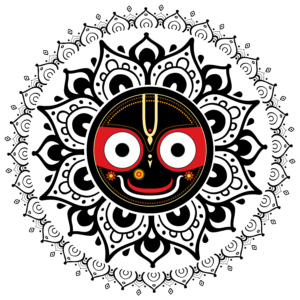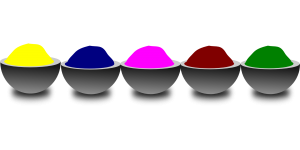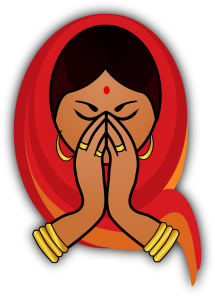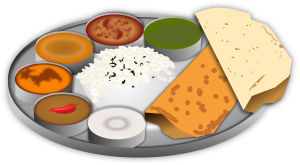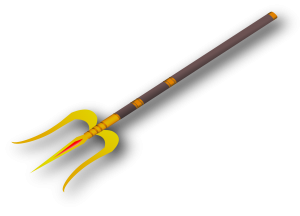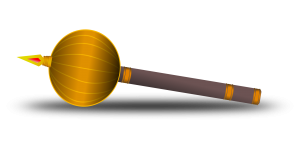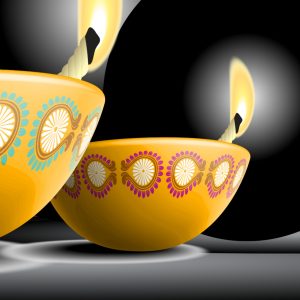

Chapter 3 from the book Śiva-Tattva: Three Considerations by Śrīla Bhaktivedānta Nārāyaṇa Mahārāja
According to philosophical truth (tattva), Śrī Kṛṣṇa’s plenary portion is Sadāśiva, and Sadāśiva’s partial 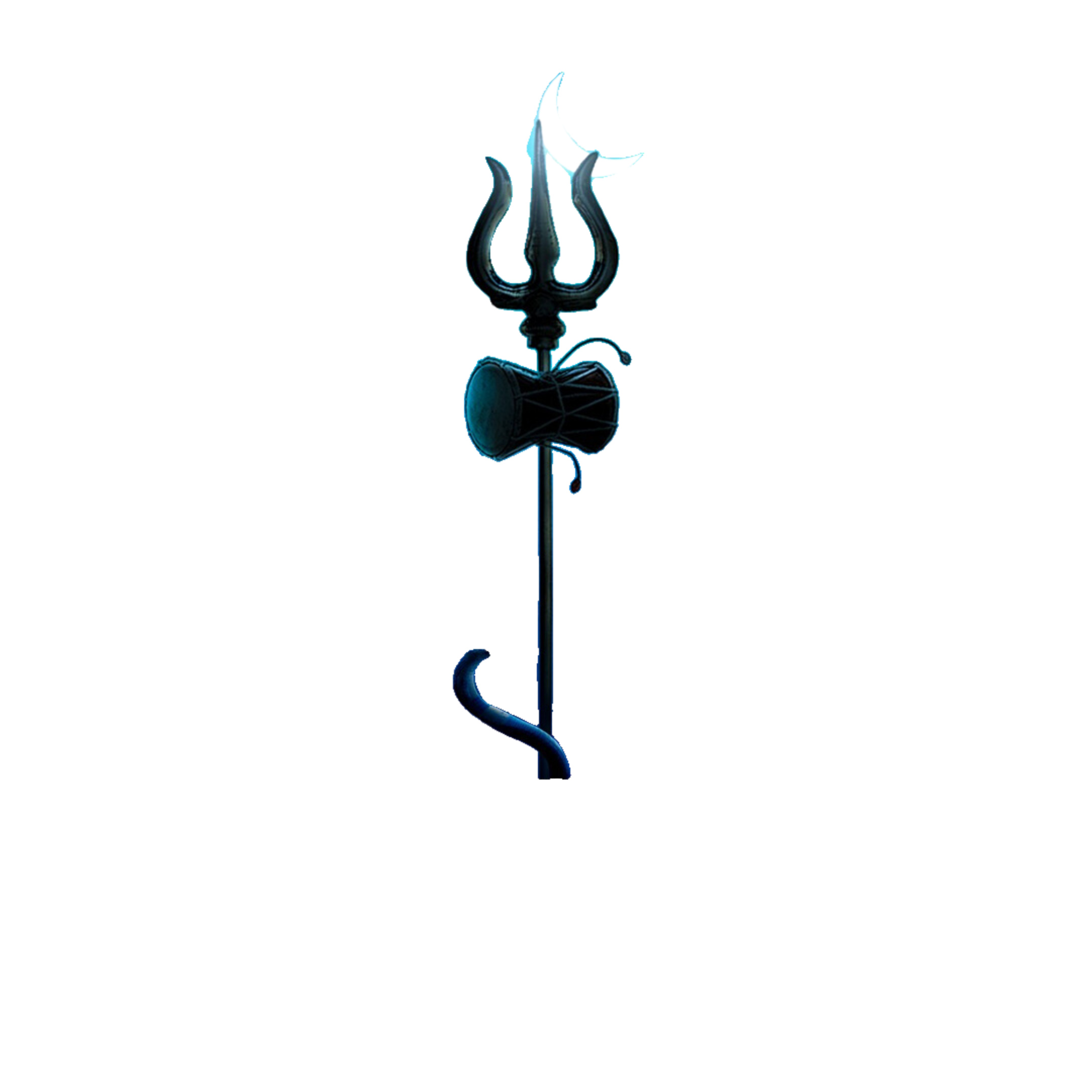 manifestation is Lord Śiva. From the perspective of Lord Kṛṣṇa’s pastimes in opulence and majesty (aiśvarya), Lord Kṛṣṇa is Śiva’s worshipful Deity, who is always loved, honoured and respected by him. However, in naravata-gata-vicāra, Kṛṣṇa plays another role – that of an ordinary human being. He performs pastimes as a very young, small child who cannot do anything independently. His mother, Śrīmatī Yaśodā-devī, feeds Him and tends to all His needs. During these human-like pastimes, Lord Śiva might come and give Him benedictions. In the scriptures called the Purāṇas it is stated that when Kṛṣṇa resided in Dvārakā, He worshipped Śiva to beget a child from the womb of His wife Jāmbavatī. Although Śiva is worshipped by Kṛṣṇa in those pastimes, he never thinks of himself as superior. He is always conscious that Kṛṣṇa is the Supreme Personality of Godhead and that he is Kṛṣṇa’s eternal servant.
manifestation is Lord Śiva. From the perspective of Lord Kṛṣṇa’s pastimes in opulence and majesty (aiśvarya), Lord Kṛṣṇa is Śiva’s worshipful Deity, who is always loved, honoured and respected by him. However, in naravata-gata-vicāra, Kṛṣṇa plays another role – that of an ordinary human being. He performs pastimes as a very young, small child who cannot do anything independently. His mother, Śrīmatī Yaśodā-devī, feeds Him and tends to all His needs. During these human-like pastimes, Lord Śiva might come and give Him benedictions. In the scriptures called the Purāṇas it is stated that when Kṛṣṇa resided in Dvārakā, He worshipped Śiva to beget a child from the womb of His wife Jāmbavatī. Although Śiva is worshipped by Kṛṣṇa in those pastimes, he never thinks of himself as superior. He is always conscious that Kṛṣṇa is the Supreme Personality of Godhead and that he is Kṛṣṇa’s eternal servant.
It is essential to have a clear understanding of these truths. One who knows these three perspectives or considerations can understand the relationship between Lord Śiva and his Lord.
According to the principle of philosophical truth, Lord Śiva is a partial manifestation of Śrī Kṛṣṇa’s plenary 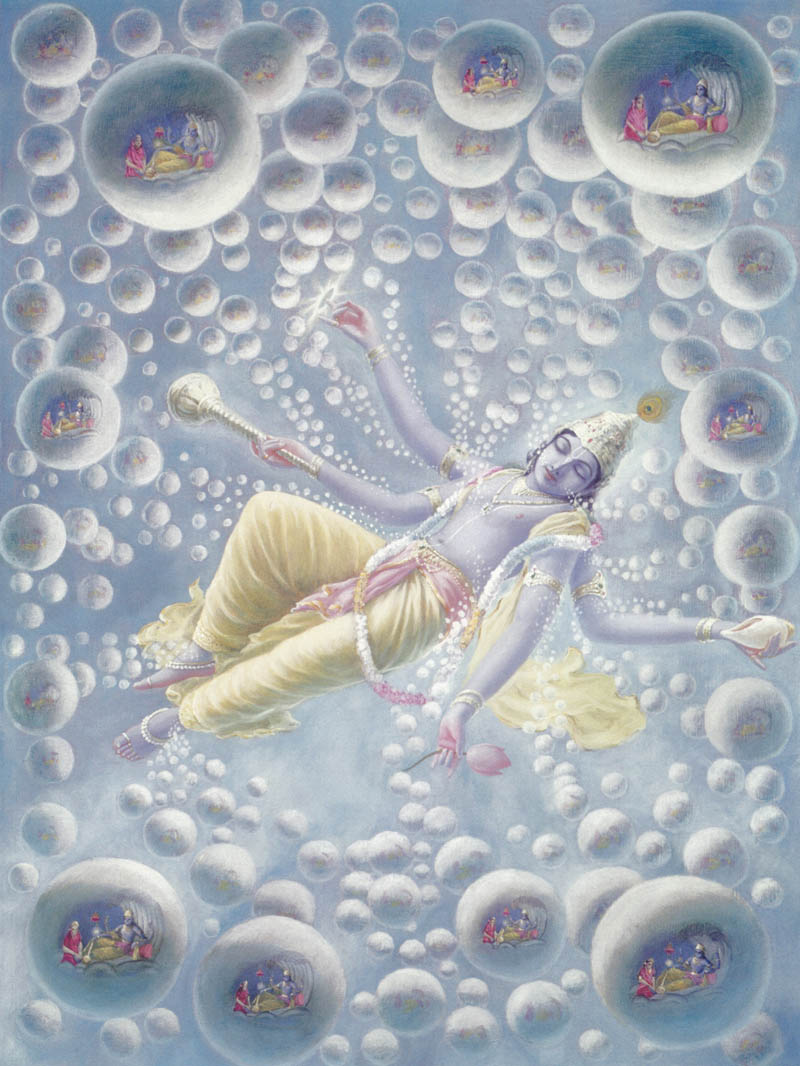 expansion, Sadāśiva. When Kṛṣṇa desires to create, He expands Himself as Mahā-Saṅkarṣaṇa, and possessing this creative desire, Saṅkarṣaṇa expands as Mahā-Viṣṇu (Kāraṇodakaśāyī Viṣṇu). Mahā-Viṣṇu then desires to create, and His desire takes the form of a light that emanates from between his eyebrows. The semblance or dim twilight reflection of that light is called Śambhu-liṅga (Śiva). Many people worship Lord Śiva in the form of Śambhu-liṅga. The light itself is eternal and is not Śambhu-liṅga; Śambhu-liṅga is its semblance or shadow.
expansion, Sadāśiva. When Kṛṣṇa desires to create, He expands Himself as Mahā-Saṅkarṣaṇa, and possessing this creative desire, Saṅkarṣaṇa expands as Mahā-Viṣṇu (Kāraṇodakaśāyī Viṣṇu). Mahā-Viṣṇu then desires to create, and His desire takes the form of a light that emanates from between his eyebrows. The semblance or dim twilight reflection of that light is called Śambhu-liṅga (Śiva). Many people worship Lord Śiva in the form of Śambhu-liṅga. The light itself is eternal and is not Śambhu-liṅga; Śambhu-liṅga is its semblance or shadow.
There is another semblance called Yoni, and this is the shadow of Ramā-devī. Ramā-devī is the spiritual potency of Mahā-Viṣṇu, and in Vaikuṇṭha she is Lord Nārāyaṇa’s beloved consort Lakṣmī-devī. This is her original transcendental form, and her shadow is the limited conceiving potency – Yoni.
Mahā-Viṣṇu has two types of potency with which he creates the material worlds. One type of potency is called nimitta – the instrumental cause of creation, and the other is called upādāna – the ingredient cause. Instrumental and ingredient causes can be explained in this way: Suppose I say, “I killed a snake with a stick.” The person who desired and performed the activity is the instrumental cause (nimitta), and the stick is the ingredient cause (upādāna). In another example, a potter makes a pot. The desire or will of the potter to make the pot is the instrumental cause. The sum total of all the instruments used to create it, like the wheel, clay, mud and water, is the ingredient cause.
Mahā-Viṣṇu’s eternal instrumental potency takes its reflected form as Yoni, the limited shadow potency, and the 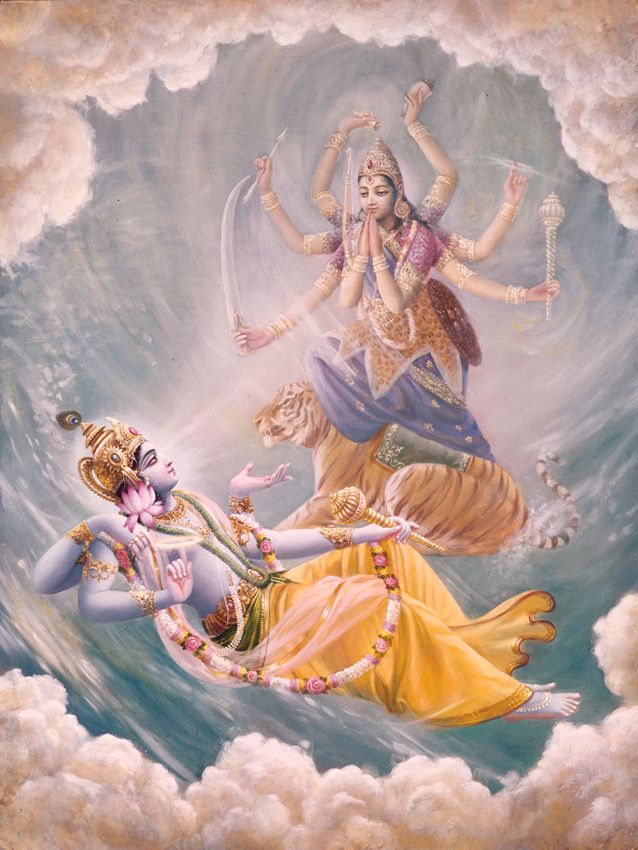 ingredient cause assumes the reflection form of Śambhu-liṅga. Creation then takes place through the union of Śambhu-liṅga and his female consort Yoni. Śambhu is called the liṅga of the Supreme Lord, which means that he is the manifest symbol of the Lord’s male generative capacity, and he appears for the purpose of preparing the cosmic manifestation. That potency which gives birth to the material creation is the energy called Māyā, and her intrinsic form is Yoni.
ingredient cause assumes the reflection form of Śambhu-liṅga. Creation then takes place through the union of Śambhu-liṅga and his female consort Yoni. Śambhu is called the liṅga of the Supreme Lord, which means that he is the manifest symbol of the Lord’s male generative capacity, and he appears for the purpose of preparing the cosmic manifestation. That potency which gives birth to the material creation is the energy called Māyā, and her intrinsic form is Yoni.
The original instrumental and ingredient cause is not Yoni and Śambhu; it is Mahā-Viṣṇu. Material nature, as Yoni, desires to create by dint of the kāma-bīja (desire seed) impregnated in her, and she is therefore the secondary instrumental cause. The desire seed gave her the urge to create, and because she then wanted to create, she is called the instrumental cause. Śambhu supplies the materials of creation, and he is therefore called the ingredient cause. Śambhu, the dim reflection of the Supreme Lord’s divine desire-filled glance, consummates his union with Yoni. However, he can do nothing independent of the energy of Mahā-Viṣṇu.
Mahā-Viṣṇu is the Supreme Personified Will, and it is he who brings about the union of the two – Yoni and Śambhu. He is the divine dominating person, the plenary portion of Lord Kṛṣṇa and the creator of the mundane world. For creation to take place, there must be the desire of the Supreme Doer. He must be present. The instrumental cause and ingredient cause must be mixed with the desire or glance of Mahā-Viṣṇu.
The initial form of the creation is mahat-tattva, the sum total of twenty-four elements.* This mahat-tattva is the reflection of the kāma-bīja, the original desire-seed in Goloka Vṛndāvana. The seed of amorous creative desire in Goloka is the embodiment of pure cognition. It is a prototype of the sex desire in this mundane world, though it is located far from it. The seed of the mundane sex desire is thus the perverted reflection of the seed of the original creative desire in Goloka Vṛndāvana.
The historical narrations that follow are examples of aiśvarya-gata-vicāra, Lord Śiva’s relationship with Kṛṣṇa from the perspective of Kṛṣṇa’s majesty. Revealed in Śrīmad-Bhāgavatam, these transcendental histories demonstrate Lord Śiva’s dependence on Him. They also further reveal that when Śiva gives benedictions to Kṛṣṇa’s enemies, he does so to assist in the Supreme Lord’s pastimes, which are performed for the benefit of all beings.
Śrīmad-Bhāgavatam tells of a demon named Vṛkāsura who, desiring to enjoy Lord Śiva’s wife, Pārvatī, 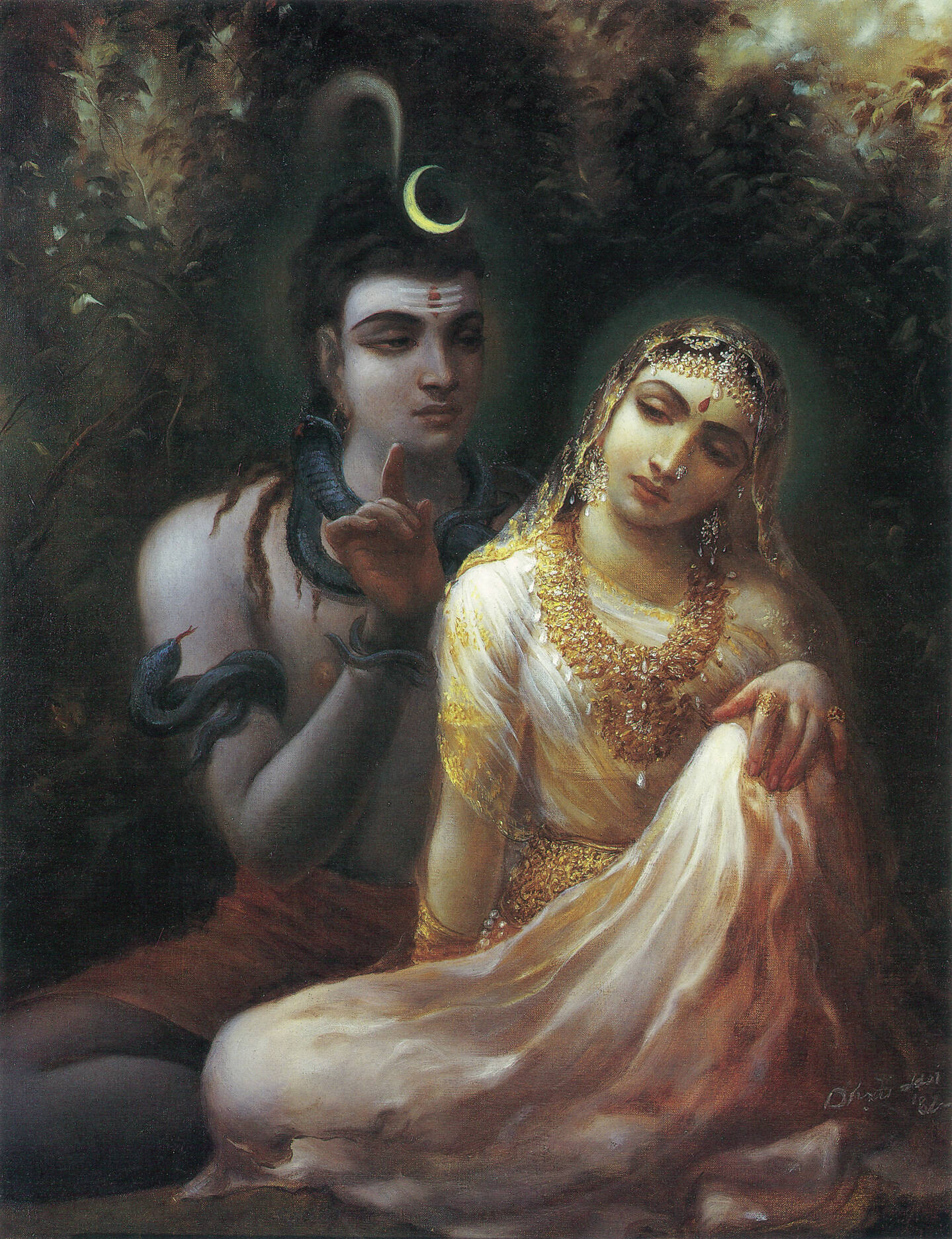 performed severe austerities to ‘please’ Lord Śiva. When Lord Śiva appeared before him to grant him a benediction, Vṛkāsura expressed his desire that as soon as he would touch the head of anyone, that person’s head would immediately split open and he would die.
performed severe austerities to ‘please’ Lord Śiva. When Lord Śiva appeared before him to grant him a benediction, Vṛkāsura expressed his desire that as soon as he would touch the head of anyone, that person’s head would immediately split open and he would die.
Lord Śiva granted this benediction, and Vṛkāsura immediately rushed forward to use it against Lord Śiva.
Śiva asked, “What are you doing?” He replied, “Now I am applying my benediction.” He did not say, “I want Pārvatī.” He simply looked at Pārvatī and then ran towards Lord Śiva. Fearful, Śiva ran away, and Vṛkāsura immediately chased after him. Lord Śiva was attired in a deerskin, which fell off, and then his ḍamaru drum also fell. He kept running, however, and he remembered his Lord. Who was the Lord he remembered? It was Śrī Kṛṣṇa. This is aiśvarya-gata-vicāra.
Lord Śiva fled from the land to the sky and from the sky to other planets, until he reached the limits of the universe, but Vṛkāsura continued to chase him. The predominating deities of higher planets, such as Brahmā, Indra and Candra, were not able to save him from the impending danger, and finally he approached Kṛṣṇa’s incarnation, Lord Viṣṇu in Śvetadvīpa.
To protect his devotee, Lord Viṣṇu appeared as a perfect brahmacārī, and the effulgence emanating from his body was attractive to both Śiva and the demon. After stopping Vṛkāsura by offering obeisances to him, and winning his confidence by speaking sweet and reassuring words, Lord Viṣṇu asked, “Why are you running after Śiva?”
Vṛkāsura replied, “He has given me the benediction that when I put my hand on someone’s head it will split open. Now I will use the benediction on him.”
Lord Viṣṇu in the dress of a brahmacārī said, “You are very foolish. Do you believe the benediction of this man who smokes gañjā, takes all types of intoxication and lives in crematoriums? Do you believe that he is authorized and powerful enough to give benedictions? His benediction will prove futile. He is just fooling you. You are running after him, but in the end you will find that his benediction is ineffective. Try it on yourself; put your hand on your head. You will see that nothing happens.”
Vṛkāsura agreed, “Yes, I will try.”
In this way, by Lord Viṣṇu’s sweet words and by the expansion of his illusory energy, the demon became bewildered. He forgot the power of Lord Śiva and his benediction. He therefore put his hand on his head, it immediately split open, and he died.
This pastime gives evidence that Lord Śiva is not independent; his worshipable Deity is Kṛṣṇa.**
All the pastimes performed by Śiva are meant to teach everyone about Śrī Kṛṣṇa’s supremacy and to inspire everyone to serve Him and take shelter of Him. The following history is another example of this.
The demigods once fought with the demons and defeated them. The demons then took shelter of their leader, 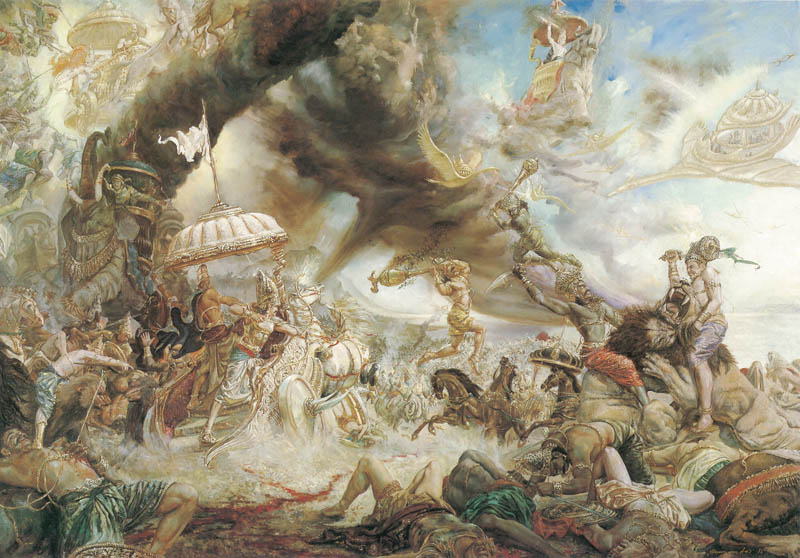 Maya Dānava, who then prepared three mystic aeroplane-like residences for them. The demons thus began to vanquish all the planetary systems.
Maya Dānava, who then prepared three mystic aeroplane-like residences for them. The demons thus began to vanquish all the planetary systems.
After that, when the demons began to destroy the higher planetary systems, the rulers of those planets went to Lord Śiva, surrendered unto him and said, “Dear Lord, we demigods are about to be vanquished. We are your followers. Kindly save us.”
Lord Śiva reassured them and said, “Do not be afraid.” He fixed his arrows to his bow and released them toward the three residences occupied by the demons, and all the demons were killed. The great mystic Maya Dānava then dropped the bodies of the demons into a nectarean well he had created, making the demons return to life and become practically invincible.
Śiva became very worried. Seeing this, Lord Kṛṣṇa in His form as Lord Viṣṇu considered how to help him destroy the demons. Lord Viṣṇu became a cow and Lord Brahmā became a calf, and they entered the residences and drank all the nectar in the well. Then, by His personal potency of religion, knowledge, renunciation, opulence, austerity, education and so on, Kṛṣṇa equipped Lord Śiva with everything he needed for the battle. He manifested a chariot, a charioteer, a flag, horses, elephants, a bow, a shield and arrows, and Lord Śiva sat down on the chariot to fight. He destroyed the three residences of the demons, the inhabitants of the higher planets glorified and worshipped him, and he became known as Tripurāri, the annihilator of the three dwellings of the demons.
So don’t fear. Kṛṣṇa will save you if you offer yourself to Him. He has promised this in the Bhagavad-gītā. If you hand over your complete responsibility in life to Him – not only your bodily maintenance but your intelligence, your senses and everything else you possess – He will take full care and responsibility for you. Don’t fear. No suffering or sorrow of any kind will be able to touch you. Moreover, you will be able to enter the realm of bhakti and be happy forever.
Further evidence of Lord Śiva’s relationship with Kṛṣṇa in the Supreme Lord’s pastimes of majesty is found in the history of Aniruddha. Aniruddha is the grandson of Lord Kṛṣṇa, and he wanted to marry the daughter of Bāṇāsura, a demonic person who was a staunch devotee of Lord Śiva. By the blessings of Lord Śiva, Bāṇāsura had one thousand arms, and he served Lord Śiva with all of them. He assisted Śiva’s famous dancing by rhythmically beating drums with his one thousand hands, and he thus received the benediction of protection from his enemies.
Kṛṣṇa was informed by Śrī Nārada that Bāṇāsura and his army had fought with and arrested Aniruddha for intimately meeting with Bāṇāsura’s daughter, Ūṣā. Therefore, to save Aniruddha, He called upon His army, the 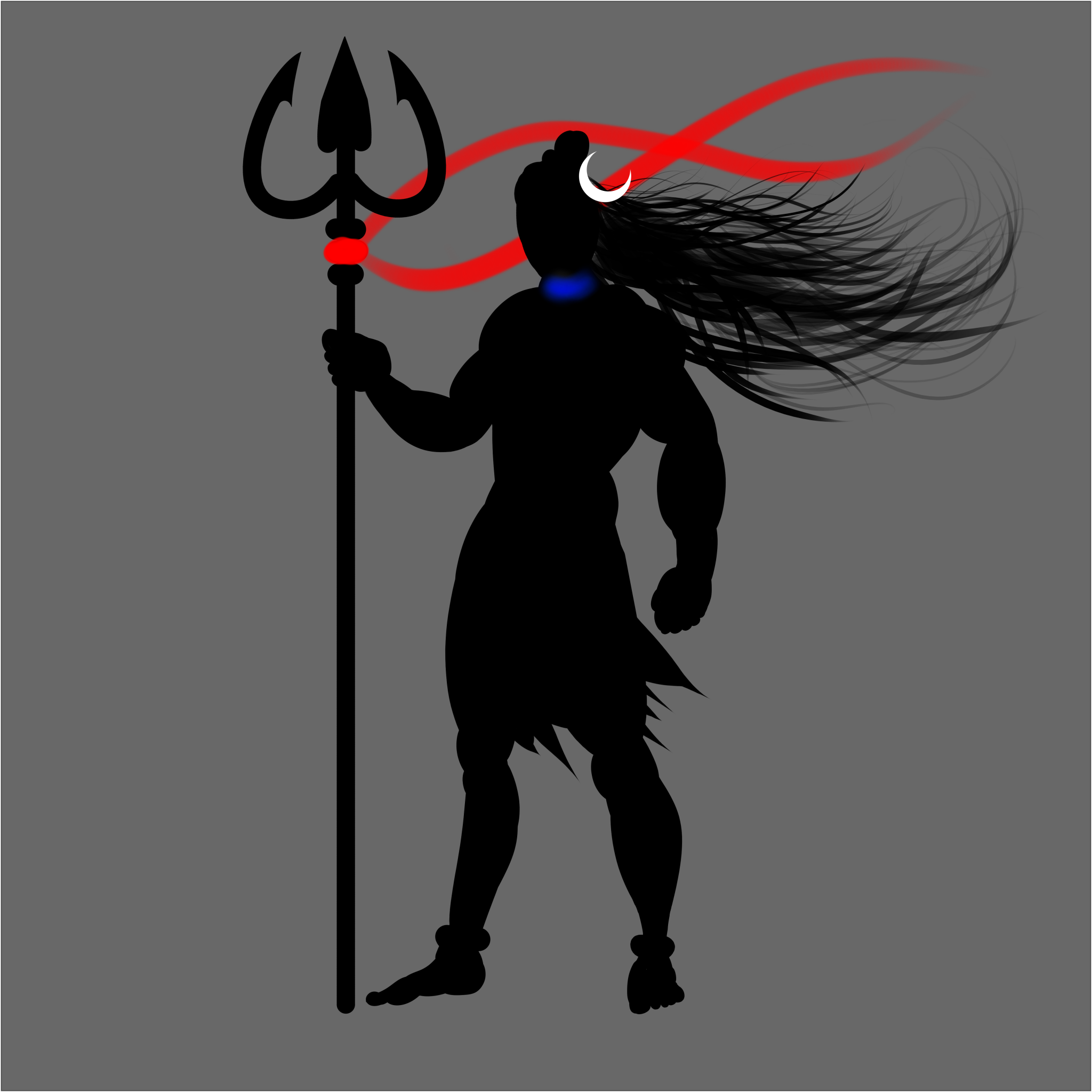 Yadu dynasty, and advanced on Bāṇāsura’s city. When Bāṇāsura saw Lord Kṛṣṇa’s army, he immediately ordered his men to fight.
Yadu dynasty, and advanced on Bāṇāsura’s city. When Bāṇāsura saw Lord Kṛṣṇa’s army, he immediately ordered his men to fight.
Lord Śiva arrived there at that time, but instead of praying to his Lord, he apparently took the side of his devotee, Bāṇāsura. He began fighting with Kṛṣṇa as Bāṇāsura’s commander-in-chief. He shot many weapons at Kṛṣṇa, including his pāśupata-astra and his ultimate weapon, the Śiva-jvara, but all of them failed.
During the battle, Bāṇāsura showered his weapons upon Śrī Kṛṣṇa with his one thousand arms. Kṛṣṇa then cut off his arms with His Sudarśana cakra, leaving him with only four. Finally Lord Śiva, realizing that he was helpless to save his devotee, surrendered to Lord Kṛṣṇa and offered his heartfelt prayers.***
After hearing Śiva’s prayers, Lord Kṛṣṇa told him that because Bāṇāsura was the son of Bali Mahārāja and the great-grandson of Prahlāda Mahārāja, and because he was favoured by Lord Śiva himself, He would not only spare Bāṇāsura’s life but would give him immortality.
According to Śrīmad-Bhāgavatam and Skanda Purāṇa, when Kṛṣṇa resided in Dvārakā, He often assumed His form as four-handed Vāsudeva. He was famous there as such. At that time there was a king named Pauṇḍraka, who had attached two artificial arms to his body and declared, “Kṛṣṇa is not the four-handed Vāsudeva. I am that Vāsudeva.” He sent a messenger to Śrī Kṛṣṇa with the declaration, “Stop claiming to be four-handed Vāsudeva. I am He.” After Lord Kṛṣṇa and His royal family laughed for a considerable time, the Lord sent a reply to the challenge and prepared to fight.
The King of Kāśī was a staunch devotee of Lord Śiva, and he took the side of Pauṇḍraka Vāsudeva. He had previously received a benediction from Lord Śiva to be able to defeat Kṛṣṇa in combat, but in this battle he was not only defeated, but killed. With the assistance of His Sudarśana cakra Śrī Kṛṣṇa killed Pauṇḍraka, and by His arrows He killed the king of Kāśī. Having cut off the head of the king, He then arranged to throw it into the city of Kāśī.
The King had a son named Sudakṣiṇa, who was determined to avenge the death of his father. Sudakṣiṇa thus worshipped the lord of Kāśī, Viśvanātha – Lord Śiva – who then instructed him to perform a special ritualistic ceremony that calls forth a fire demon to kill one’s enemy. Lord Śiva also sanctioned his ghostly companions to accompany the fire demon, and Dvārakā then fell under attack.
Kṛṣṇa called for his Sudarśana cakra, which froze the demon and forced him to return to Kāśī and destroy his creators. Moreover, following behind the demon, the Sudarśana cakra burned the entire city to ashes.
At that time even Lord Śiva himself had to run from the city. Where his deerskin fell, he did not know. He also left his trident and everything else, including his wife, and quickly fled. He arrived at a place in Navadvīpa**** called Harihara-kṣetra, and there he took shelter of Śrī Caitanya Mahāprabhu.*****
From Navadvīpa he went to Ekāmra-kānana [now Bhuvaneśvara] near Purī, in Orissa, where he took shelter of Śrī Kṛṣṇa in His form as Lord Jagannātha. This pastime is aiśvarya-gata-vicāra, and it also reveals that the worshipable Deity of Lord Śiva is Śrī Caitanya Mahāprabhu or Śrī Kṛṣṇa.
Lord Rāmacandra’s worship of Lord Śiva is an example of naravata-gata-vicāra – a sweet, human-like pastime. As stated earlier, Rāma played the role of an ordinary human being who had to perform the difficult task of crossing the ocean to reach Laṅkā, and he worshipped Lord Śiva for the power to do this.
Lord Rāma established a liṅga of Rāmeśvara Mahādeva and began worshipping him, thinking, “By Lord Śiva’s  mercy I can cross the sea.” Actually he was powerful enough to personally jump across the ocean in a second, but he was playing a role to inspire ordinary people. The common people present considered that Rāmeśvara Mahādeva was the lord of Rāma, and that was why his name was Rāmeśvara. The demigods then appeared and declared, “Rāmeśvara Mahādeva and Rāma are both the same. There is no difference between them. Both are īśvara; both are God, the Supreme Lord. Ordinary people think only that Rāmeśvara is the lord of Rāma, but they are not intelligent. It is not like that.” At that moment Lord Śiva manifested from the liṅga and said, “No. Try to understand this truth. Rāmeśvara means ‘He whose Lord is Rāma.’ Rāma is my Lord!”
mercy I can cross the sea.” Actually he was powerful enough to personally jump across the ocean in a second, but he was playing a role to inspire ordinary people. The common people present considered that Rāmeśvara Mahādeva was the lord of Rāma, and that was why his name was Rāmeśvara. The demigods then appeared and declared, “Rāmeśvara Mahādeva and Rāma are both the same. There is no difference between them. Both are īśvara; both are God, the Supreme Lord. Ordinary people think only that Rāmeśvara is the lord of Rāma, but they are not intelligent. It is not like that.” At that moment Lord Śiva manifested from the liṅga and said, “No. Try to understand this truth. Rāmeśvara means ‘He whose Lord is Rāma.’ Rāma is my Lord!”
The pastimes of Lord Rāma are found in Rāmāyaṇa, Śrīmad-Bhāgavatam, the Purāṇas and Rāma-carita-mānasa, and they take place in a previous age, called Tretā-yuga. The demonic king Rāvaṇa had kidnapped Lord Rāma’s wife, Sītā-devī, and taken her to Laṅkā. Before Rāma knew where Sītā had been taken, he was weeping profusely, and Lakṣmaṇa was trying to console him. The more Lakṣmaṇa tried to pacify him, however, the more bitterly he wept. In this state of mind, he was beseeching the trees and creatures of the forest, and even the Godāvarī river. He appealed to the trees of the Panjātavi forest, “O Panjātavi, have you seen Sītā? Where has she gone? O deer, have you seen Sītā? O Godāvarī, have you seen my dear Sītā? Why has she left me?” Lord Rāma became maddened by inconsolable grief.
At this time Lord Śiva and his wife Satī came to Daṇḍakāraṇya forest, where Lord Rāma had been living with Sītā and His brother Lakṣmaṇa for fourteen years, following the order of His father, King Daśaratha. Śiva was thus present to witness Lord Rāma’s divine pastimes, and seeing them, he was moved; his heart melted. He offered full obeisances, with all the limbs of his body touching the ground, and glorified Rāma: “Oh! These pastimes are so beautiful and marvellous that they will melt the heart of anyone who sees them.” He then circumambulated the outer precincts of that area, weeping due to the transcendental emotions of grief in separation exhibited in his Lord’s pastimes.
Offering his final respects, Śiva was ready to return to Kailāsa, when Satī asked him, “My dear husband, to 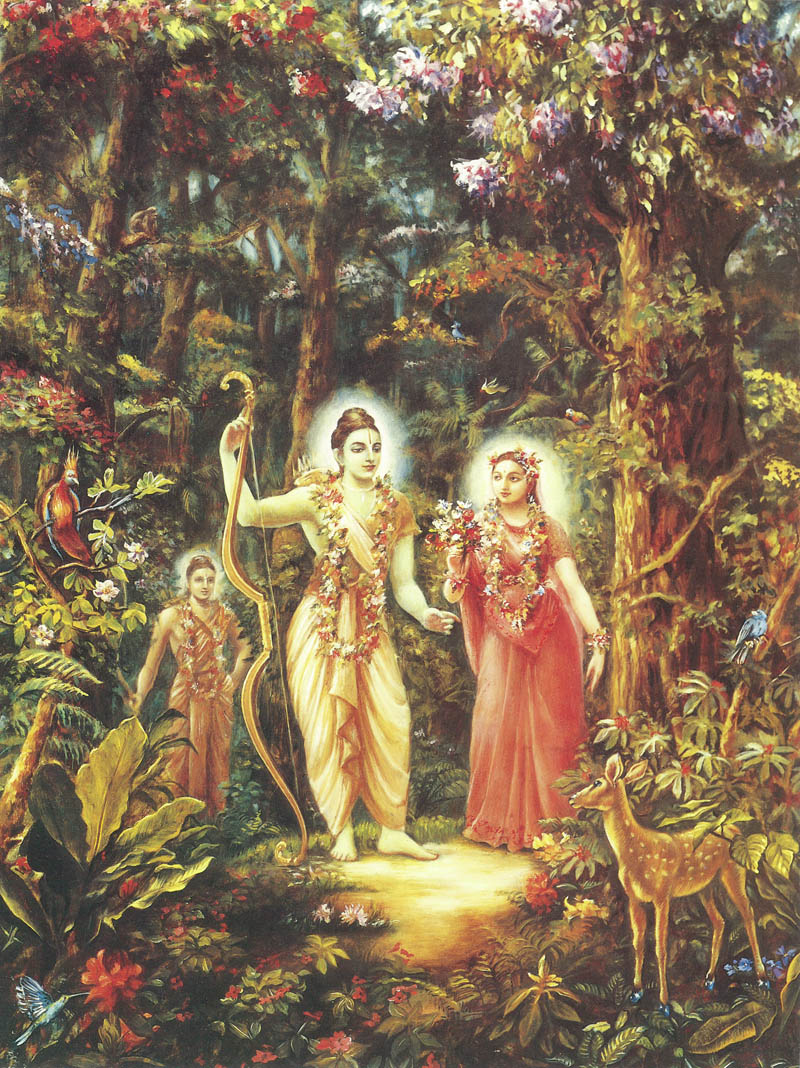 whom are you offering obeisances?” Lord Śiva replied, “Śrī Rāma is my worshipful Deity. I worship him always.” Satī said, “I see that Rāma is like an ordinary man weeping for his wife. Even I know where Sītā is, but he does not know. Why is he grieving? He appears to be a weak person. Is he not strong enough to bring Sītā back? He must be an ordinary man, not God. Why are you honouring him so?”
whom are you offering obeisances?” Lord Śiva replied, “Śrī Rāma is my worshipful Deity. I worship him always.” Satī said, “I see that Rāma is like an ordinary man weeping for his wife. Even I know where Sītā is, but he does not know. Why is he grieving? He appears to be a weak person. Is he not strong enough to bring Sītā back? He must be an ordinary man, not God. Why are you honouring him so?”
“You are ignorant,” Lord Śiva told his doubting wife. “You do not understand that Rāma is the Supreme Personality of Godhead.” He told her that if she did not believe him she could conduct a test of some sort, to determine Śrī Rāma’s position.
Lord Śiva rested under a banyan tree a little distance away, and Satī, by her inherent mystic power, changed to a form like Sītā’s. She went to the area where Śrī Rāma was piteously searching for Sītā. She thought that if she would appear before Rāma as Sītā, he would come and embrace her in joyous relief, believing that he had found His wife. However, although she appeared before him again and again, He ignored her each time. He simply looked away. Finally he said to her, “Mother, why are you roaming alone here in the forest? Where is your husband, Śiva?”
Satī became astonished and fearful and wondered how Rāma knew who she was. She knelt in reverence, and at that time she no longer saw the trees, plants, and wildlife of the forest as before. She saw Sītā-Rāma everywhere and in everything. Wherever she looked in the forest – here, there and everywhere – she saw only Sītā-Rāma, Sītā-Rāma, Sītā-Rāma.
In this manner, Śrī Rāma showed Satī that he and Sītā are eternally inseparable, that he was performing this dramatic pastime to captivate the minds of human beings by its remembrance, and that he is, in fact, the Personality of Godhead. She reflected, “My husband is never ignorant. He was right and I was wrong.” Rising to her feet, she saw that Rāma was still there alone in the forest with Lakṣmaṇa, weeping, “Oh Sītā, where are you, where are you?”
Then, reassuming her form, she returned to the spot where Śiva was waiting under the banyan tree. He asked her, “Did you test him to see who he is?”
Satī lied, “Most respected husband, I believed you; so there was no need to test him.”
Lord Śiva saw in a trance what had actually happened and silently vowed, “Satī has taken the form of Sītā, my mother; therefore she is no longer my wife. She is now my mother, and from now on I will treat her as such.”
When he made this vow, the demigods at once showered flowers from heaven, and they praised him, “You have made a remarkable vow.” Satī asked, “What vow did you make?” Śiva remained silent.
The bona fide disciple always has faith in his self-realized guru. Lord Śiva was the Guru of Satī, but she did not believe him when he told her that Rāma is the Supreme Personality of Godhead. If a disciple does not obey his gurudeva, his bhakti and spiritual life will diminish. If a disciple lies to his gurudeva, he again goes to hell.
When Lord Śiva and Satī-devī returned to their cottage in Kailāsa, Śiva placed her seat facing him. In Vedic culture, a wife sits on the left side of her husband and a mother, respected as guru, sits in front of her son, facing him.
A disciple does not offer obeisance to his gurudeva from his guru’s right or left side, but always in front of him. A true disciple does not remain silent, but respectfully asks relevant questions of his guru and serves him. He does not ask questions in a challenging mood, but rather to learn. It is stated in Bhagavad-gītā (4.34):
tad viddhi praṇipātena
paripraśnena sevayā
upadekṣyanti te jñānaṁ
jñāninas tattva-darśinaḥ
Just try to learn the truth by approaching a spiritual master. Inquire from him submissively and render service unto him. The self-realized souls can impart knowledge unto you because they have seen the truth.
Lord Śiva entered a trance for thousands of years, and Satī felt severe separation from him. She thought, “Śiva has left me. He is treating me like his mother because I took the form of Sītā. As long as I am in this body he will not accept me as his wife, so I will have to give up this body.”
After some time, Satī’s father Dakṣa, the son of Lord Brahmā and great progenitor of the universe, began a sacrifice. Although every sacrifice is intended to please the Supreme Lord Viṣṇu, all the demigods, especially Lord Brahmā, Lord Śiva and the other principal demigods, are invited and take part. However, Lord Śiva was not invited to Dakṣa’s sacrifice.
The chaste Satī heard the heavenly denizens, who were flying in the sky, speaking about the great sacrifice being performed by her father. She saw that the wives of the heavenly denizens, dressed in fine clothing, were coming from all directions and were going to the sacrifice. She approached her husband and said, “My dear Lord, your father-in-law is now performing a great sacrifice. All the demigods who were invited by him are going. If you desire, we may also go.”
Lord Śiva warned her not to go, due to her father’s enmity and envy towards him – an enmity that had begun long before, in a former age. Lord Śiva now remembered his father-in-law’s harsh words spoken at that time. Śiva had come to Dakṣa’s council, where Dakṣa was being honoured by many leaders of the universe. Dakṣa’s daughter was married to Lord Śiva, so he considered Śiva to be like his son. He offered obeisances to Brahmā because Brahmā was his father, but he did not show any respect to Śiva. Lord Brahmā welcomed Dakṣa, but Śiva was absorbed in meditation and chanting the mahā-mantra: “Hare Kṛṣṇa Hare Kṛṣṇa Kṛṣṇa Kṛṣṇa Hare Hare, Hare Rāma Hare Rāma Rāma Rāma Hare Hare.”
Insulted by Śiva’s apparent neglect and considering himself Śiva’s superior, Dakṣa publically criticized him. Many incidents occurred because of that, and Śiva returned to Kailāsa. Previous to this, Dakṣa had often criticized Śiva, being disturbed that his daughter had married such an ‘inferior person’, but after this incident he considered Śiva his enemy. Lord Śiva, on the other hand, had never felt enmity towards Dakṣa.
Lord Śiva told Satī, “A woman can go without an invitation to see her guru or her father and mother, but if her father thinks that her husband is his enemy, then she should not go to see him. You know that your father thinks I am his enemy, although I have never considered him as such.”
Despite her husband’s words, Satī was determined to go. She went, but upon her arrival she observed Dakṣa 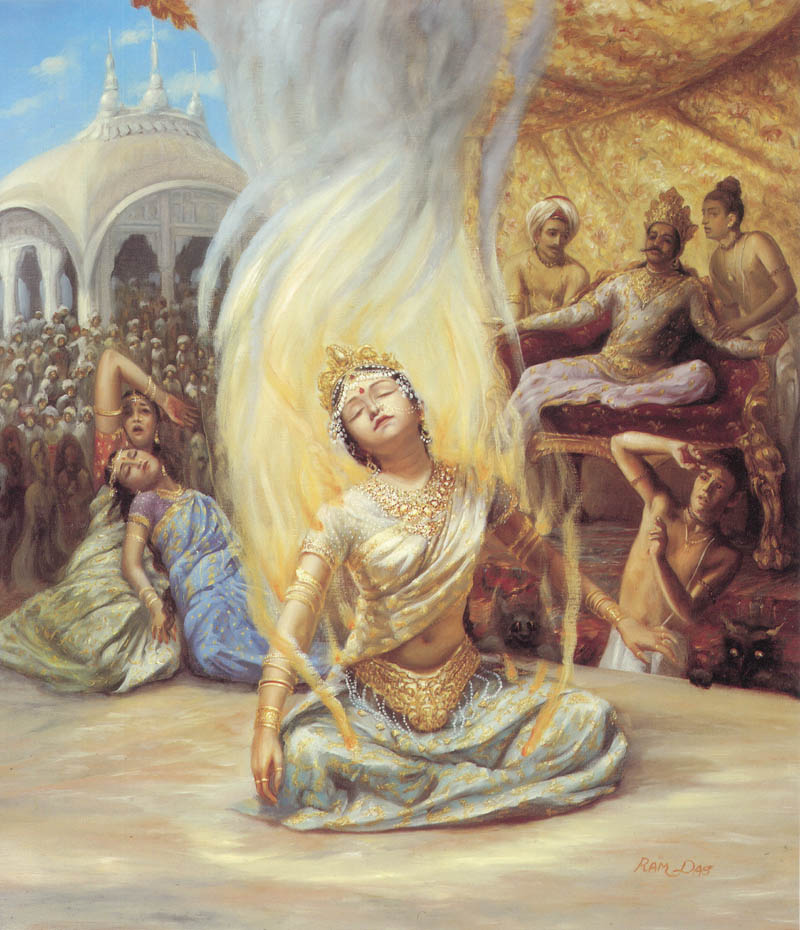 dishonouring him. She angrily condemned her father and glorified Lord Śiva in front of all present. Then, while meditating on Lord Śiva’s holy lotus feet, she gave up her body in a mystic fire that manifested from her heart.
dishonouring him. She angrily condemned her father and glorified Lord Śiva in front of all present. Then, while meditating on Lord Śiva’s holy lotus feet, she gave up her body in a mystic fire that manifested from her heart.
By quitting her body, Satī was able to disconnect herself from her offensive father and transfer herself to another body to associate with Lord Śiva without that contamination. However, her main motive was to become free from the result of her offences, and again be accepted as Lord Śiva’s beloved wife. In her next life she took birth as Pārvatī, the daughter of the Himālayas. In that birth she performed austerities for many years and achieved her desired goal.
Here we see that Śiva’s worshipable Deity is Rāma, and because Satī took the form of Sītā-devī, he left her. He is a chaste Vaiṣṇava, always serving Lord Kṛṣṇa and Lord Rāma. Satī-devī is also a pure devotee. She is the Supreme Lord’s divine energy, but she plays a role in giving lessons to ordinary people.
Both Śiva and Satī served in Lord Rāma’s human-like pastimes. Rāvaṇa had not taken the real Sītā. He was not able to touch her. He could only take a māyā-sītā. The real Sītā, the transcendental potency of Rāma, was taken away and protected by the lord of fire, Agnideva. Rāma’s crying and asking every plant, tree, mountain and river, “Where is my Sītā?” was an exhibition of his human-like pastimes.
The great saint Tulsīdāsa has written in his Rāma-carita-mānasa that we should accept Śrī Śiva-Pārvatī as our Guru, and they will give us love for the lotus feet of Rāma. Those who worship Śiva as an independent lord are like Vṛkāsura. They want to have sense gratification with Kṛṣṇa’s potency. Instead of becoming Vṛkāsura, we should become devotees, and consider Śiva-Pārvatī as our Guru in the matter of devotion to the Supreme Lord.
Consider further the identity of Lord Śiva’s worshipable Deity. Śiva’s mantra is Rāma, and he always chants the holy name of Rāma. To whom does this refer? Although this also refers to Śrī Sītā-Rāma, the name he chants is that of Mūla-Saṅkarṣaṇa, Balarāma, the first expansion of Lord Kṛṣṇa. Śrī Rāmacandra is also an expansion of the original Rāma – Balarāma – but the factual worshipable Deity of Lord Śiva is Balarāma.
Ultimately, in the Hare Kṛṣṇa mahā-mantra, Rāma does not refer to Daśaratha’s son Rāma, nor to Paraśurāma or Balarāma. Lord Rāmacandra, Lord Paraśurāma and Lord Balarāma are all manifestations of Śrī Rādhā-ramaṇa.
Hare Kṛṣṇa Hare Kṛṣṇa Kṛṣṇa Kṛṣṇa Hare Hare
Hare Rāma Hare Rāma Rāma Rāma Hare Hare
The meaning of Rāma here is Rādhā-ramaṇa, Śrī Kṛṣṇa who engages in ramaṇa with Rādhā. Ramaṇa means playing or enjoying. Kṛṣṇa enjoys playful pastimes with Rādhārāṇī, and He is therefore called Ramaṇa or Rāma.
The following history is another example of naravata-gata-vicāra, or mādhurya-gata-vicāra. There is also some tattva-gata-vicāra here, and altogether it is a nectar cup full of mādhurya (sweetness) and tattva (philosophical truth) – tasting very good.
Lord Śiva is immensely powerful and he has no lust. He may even be naked, and his wife Pārvatī may also be sitting naked on his lap, but they have no lusty desires. If an ordinary girl and boy stay close together, especially without clothes, lust will enter their hearts. However, this fall down does not take place in the hearts of Lord Śiva and Pārvatī-devī under any circumstance.
In this regard, a transcendental pastime is described in the Sixth Canto of Śrīmad-Bhāgavatam. Lord Śiva was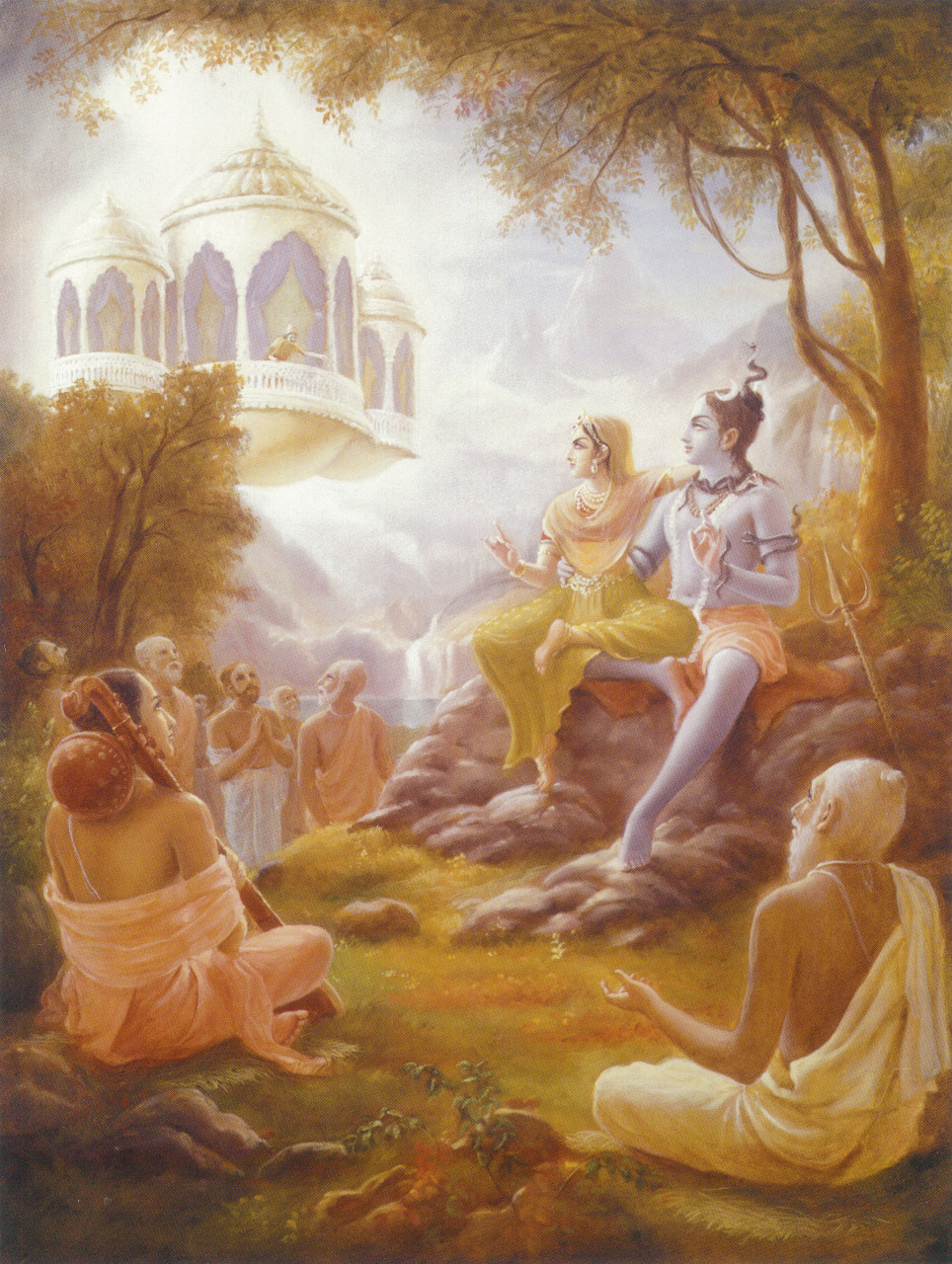 once giving a lecture in an assembly of great saintly persons, Pārvatī was sitting on his lap, and both of them were completely naked. At that time the exalted devotee King Citraketu came and said in a friendly way, “Just see the position in which you are giving your lecture.” Pārvatī thought that he was criticizing Lord Śiva. Disturbed by the thought that anyone would think Lord Śiva has lusty desires in his heart, she cursed him.
once giving a lecture in an assembly of great saintly persons, Pārvatī was sitting on his lap, and both of them were completely naked. At that time the exalted devotee King Citraketu came and said in a friendly way, “Just see the position in which you are giving your lecture.” Pārvatī thought that he was criticizing Lord Śiva. Disturbed by the thought that anyone would think Lord Śiva has lusty desires in his heart, she cursed him.
King Citraketu was on friendly terms with Lord Śiva, and because Citraketu’s Guru is also Mūla-Saṅkarṣaṇa, he and Śiva were god-brothers. He never meant to say that lust was in Śiva’s heart. He was simply saying that this was not the standard way to deliver a lecture.
Lord Śiva chastized Pārvatī and said, “Why did you curse him? He is an exalted devotee. Look at his advancement in bhakti. Although he is quite competent to revoke your curse and curse you in retaliation, he has readily accepted your curse. This is his greatness – this is the behaviour of a Vaiṣṇava.”
Lust cannot remain near Lord Śiva. Neither Lord Sadāśiva nor his partial manifestation of Śiva who stays with Pārvatī have lust in their hearts. When Kāmadeva, Cupid, once came to disturb Lord Śiva’s meditation, Śiva simply opened his third eye and burned him to ashes.
How could it happen then, that Lord Śiva was attracted to the beautiful form of Mohinī-mūrti? Mohinī is an incarnation of Lord Kṛṣṇa Himself, and He can do anything. It was Lord Kṛṣṇa who personally created the attraction within Lord Śiva’s heart and He who showed him this form of Mohinī. In the course of serving Kṛṣṇa’s pastimes, His internal bewildering energy, yogamāyā, is so strong that it can do anything.
* Mahat-tattva: the twenty-four elements are the five gross elements, the three subtle elements, the ten senses, the five sense objects and the total material cause.
** “Thus by the grace of the Supreme Personality of Godhead Nārāyaṇa, who is transcendental to all material qualities, Lord Śiva was saved from being killed by a demon. Anyone who hears this history with faith and devotion is certainly liberated from material entanglement as well as from the clutches of his enemies.” (Kṛṣṇa, Chapter 88)
*** “Śukadeva Gosvāmī assured King Parīkṣit that the narration of the fight between Lord Śiva and Lord Kṛṣṇa is not at all inauspicious, like ordinary fights. On the contrary, if one remembers in the morning the narration of this fight between Lord Kṛṣṇa and Lord Śiva, and takes pleasure in the victory of Lord Kṛṣṇa, he will never experience defeat anywhere in his struggle of life.” (Kṛṣṇa, Chapter 63)
**** Lord Nityānanda said, “To the west of the Alakananda river see Kāśī, where the followers of Śiva and his consort endeavour for liberation. This Navadvīpa Kāśī, however, is superior to the other Kāśī. Here, Śiva is always dancing and chanting the name of Gaurāṅga (Caitanya Mahāprabhu), begging his followers to accept devotion to Mahāprabhu. The renunciates who live for a thousand years in Kāśī may attain liberation through the cultivation of knowledge leading to impersonal liberation, but here the devotees kick away that liberation as they dance and chant the name of Gaurāṅga. While leaving the body here, living entities are delivered by Lord Śiva, who chants the name of Gaurāṅga in their ears. This abode is thus called Mahā-Vārāṇasī, for here there is no fear of death.” (Śrī Navadvīpa-Māhātmya by Śrīla Bhaktivinoda Ṭhākura)
***** The identity of Śrī Caitanya Mahāprabhu is given as follows: “According to the Vedic literature, the foremost occupational duty for humanity in this Age of Kali is nāma-saṅkīrtana, or congregational chanting of the holy name of the Lord. The incarnation for this age especially preaches this process, but only Kṛṣṇa Himself can explain the confidential loving service performed in the four principal varieties of loving affairs between the Supreme Lord and His devotees. Lord Kṛṣṇa therefore personally appeared, with His plenary portions, as Lord Caitanya.” (Śrī Caitanya-caritāmṛta, Ādi-līlā, Chapter 3 Summary)
Source: Purebhakti.com
Image/Art made possible by Pixabay.com, Krishnapath.org and/or Bhaktiart.net
Unless indicated differently, all verse translations and quotes are from the books by Śrīla Prabhupāda (Vedabase.com)